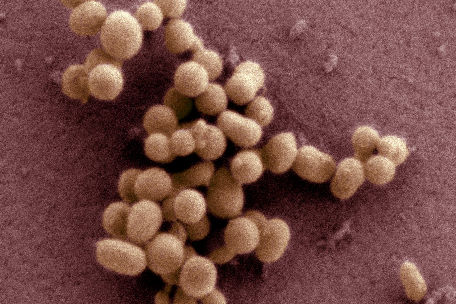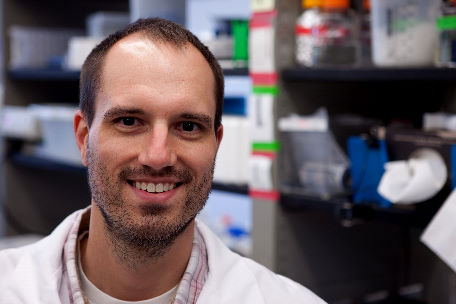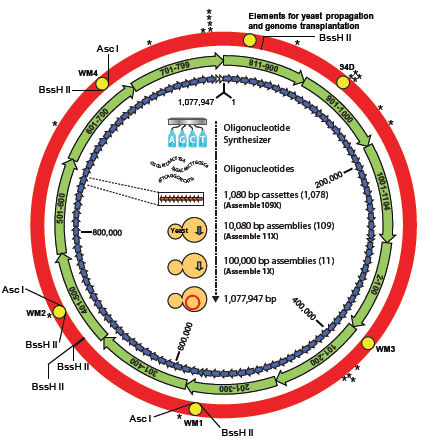The Synthetic Genome has arrived
US scientists have created a bacterium with an entirely synthetic genome.
The world of molecular biology has taken a massive step forward today, with the publication of a paper in the prestigious Science journal outlining how Craig Venter’s research team have created the first cell to be controlled by an entirely synthetic genome.
Without question, this is a significant breakthrough. Yet, it raises many moral, ethical and philosophical questions, in particular about the true nature of life itself.

Scanning electron micrographs of M. mycoides JCVI-syn1. Samples were post-fixed in osmium tetroxide, dehydrated and critical point dried with CO2 , then visualised using a Hitachi SU6600 scanning electron microscope at 2.0 keV. Electron micrographs were provided by Tom Deerinck and Mark Ellisman of the National Center for Microscopy and Imaging Research at the University of California at San Diego. (Image: JCVI)
Craig Venter’s revolutionary project cost US$30 million (A$36 million) to fund and has taken 15 years to achieve. The research programme was lead by Dr. Daniel Gibson (under the guidance of Dr. Craig Venter, one of this century’s most distinguished geneticists) and has involved more than 20 scientists. The team has successfully created an entire bacterial genome synthetically and then transferred that genome into a different species of bacterium, which has then replicated itself in the lab under the control of the synthetic genome.

Dr. Daniel Gibson. (Image: JCVI)
The science behind this development is complicated, and almost impossible for a lay person to comprehend without a good understanding of biology and molecular genetics. Therefore, I have tried to summarise the concepts to a level that a person with high school or first year biology should mostly understand.
Developing the Synthetic Genome (In brief)
To achieve the synthetic genome, Craig Venter and his team sequenced the genome of Mycoplasma mycoides subsp. capri (strain GM12), a bacterium that causes lung disease in cows and goats. Using computer software, the genome sequence was ‘corrected’ so that a consensus sequence was generated. In addition, to allow for future identification of this synthetic genome, four ‘watermark’ sequences were inserted. The ‘watermark’ sequences encode unique identifiers whilst limiting their translation into peptides.
From there, small gene fragments (cassettes) of approximately 1080bp length were prepared from chemically-synthesised oligonucleotides manufactured by Blue Heron. A total of 1078 of these small gene cassettes were incorporated into yeast cells and cultured.
From these, 10kb synthetic intermediate cassettes were generated by extracting the 1kb cassettes from yeast, joining them within a vector and inserting them into E. coli which was then cultured. The E. coli strains that contained the synthetic inserts were then identified.
Form those 10kb fragments, eleven 100kb synthetic intermediates were assembled and transformed back into yeast. An electrophoresis gel was used to confirm which yeast plasmids contained the full insert. The plasmids were then purified to remove all traces of yeast chromosomal DNA.
From those eleven 100kb intermediates, the synthetic genome was assembled, then re-inserted into yeast. From there, the M. mycoides synthetic genome was transformed into M. capricolum cells.
Under the total control of the M. mycoides synthetic genome, the M. capricolum cells were proliferated in the lab.
Because the M. capricolum cells weren’t created de nov0 (ie: the synthetic genome was inserted into existing cells), the proteins for the original genome remained in the cells for a while. But with the passing of several generations, the new synthetic genome took over and the cells took on an appearance (phenotype) consistent with the new synthetic genome.

The assembly of a synthetic M. mycoides genome in yeast. (Image: JCVI)
Implications
Whilst from a biological perspective, this is a brilliant scientific endeavour, it raises a lot of very deep philosophical questions. Most importantly: What is the essence of life?
Some argue that genetic engineering is “tampering with nature”. I reject such an argument, as hybridisation and ‘traditional’ breeding are essentially a less-efficient form of the same process of selecting genes in and out of populations with the exception that it has been practised for several thousand years.
But the process of adding an entirely synthetic genome (even if it is a copy of an existing genome) provides a deeper moral conundrum on two levels: (1) Will this lead to the de novo synthesis of life (ie. “playing God”) and (2) How will such technology be used?
On an ethical level, I cannot immediately say whether there is a legitimate moral objection to this technology based on an interpretation of Christian theology and/or general ethics. That said, some Bishops in Rome have expressed some concerns.
To understand the nature of de novo life, we first have to ask ourselves about the nature of death, and in the case of higher organisms, murder or killing. Under ordinary circumstances, causing cells to stop respiring almost always causes them to die, and therefore that is an act of killing those cells (and potentially the organism if certain cells are targeted). Such non-respiring cells are unquestionably dead. But what if we instead substitute those cells’ (or organism’s) entire genome with another?
The cells are still alive because they are still respiring, and therefore they haven’t died. But their fundamental character or nature has been destroyed. Under such a scenario where we replace the genome of an entire organism with another, we have to ask ourselves, have we then killed that organism’s character (and therefore them) by destroying their genome?
To illustrate this point, imagine that a brain transplant were possible. Would the substitution of a person’s brain with another be an act of murder, when the body remains alive? If we accept that the person’s nature/character/soul exists within their brain, then perhaps yes, it is murder. If we argue on biological terms that respiration continues and the body remains alive, then it surely isn’t murder at all.
This is the conundrum that we as a society will have to grapple with, as synthetic genome technology is further developed and applied to mammalian (and possibly human) cells in future, such as embryos (for example). If the technology is imported into existing cells/organisms, and we feel that this could be interpreted as an act of murder, then moral objections will probably make the technology ethically bankrupt. If we don’t accept this viewpoint, then there is possibly no direct ethical problem with proceeding. The ethical issue might then lie with how the technology would be used rather than the technology itself.
At present, we can only import a genome into an existing yeast cell (created by God/existing in nature). If we were also eventually able to synthesise functional cell membranes, organelles, and cytoplasm artificially to compliment our synthetic genome, then perhaps we are not guilty of murder or killing when the genome is added, as no organism has been destroyed.
That said, if such ‘synthetic cells’ can be created so that they can respire on their own, are we then really creating de novo life at odds with God’s Law/The Law of Nature? Or are we merely creating a sophisticated robot that is capable of ‘synthetic respiration’ and therefore we’re crossing no moral-ethical boundary? To decide whether such an approach is morally/ethically legitimate, we need to decide the boundaries between robot and organism and living or non-living. In essence: We need to define life.
At this moment in time, I really have no firm view other than to say that the creation of de novo life forms leaves me feeling quite uneasy. I will require further time to consider my full position on this matter. I will be listening carefully to the public debate that will no doubt follow.
So what is the point of this technology, really?
With all these potential ethical-moral problems, we really need to step back and ask ourselves, “What do we have to gain from this technology?”.
As it turns out, quite a lot.
Aside from its application in better understanding cell biology and genetics, such technology could be used to do considerable good.
Maryland biophysicist Dr David Thirumalai told the ABC’s AM programme that such technology could be used to create synthetic cells to heal particular parts of the body or to create synthetic organisms to clean up an oil spill. Many would argue that this is a decent, humane and ethical application of the technology.
Perhaps we could create blood cell lines that destroy viruses such as HIV? Or use those cells to create industrial biofuels? Perhaps we could create tiny organisms that convert carbon dioxide back into oxygen more efficiently than plants or synthetic trees, thus reversing the effects of Climate Change.
That said, such technology could also be used to enable despotic regimes to create nastier and more virulent forms of biological weapons.
The possibilities of this technology are endless, as are the ethical, moral and philosophical questions. Already today, the US president has announced an investigation into the use of synthetic genome technology. No doubt Australian authorities will announce a similar investigation soon.
Venter’s team have announced that their next target will be to apply their technique in adding a synthetic genome to an algae.
In their scientific manuscript, Dr. Daniel Gibson and Dr. Craig Venter write that their approach to creating synthetic cells might eventually “be applicable to the synthesis and transplantation of more novel genomes as genome design progresses” but counsel that they “… anticipate that (their) work will continue to raise philosophical issues that have broad societal and ethical implications”.
Lets hope that synthetic genomic technology, if adopted, will be used for good instead of evil. Lets hope that as a global community, we can have an inclusive debate about the proper use of such technologies.
Further Information
This article is based on the manuscript published in Science today:
D.G. Gibson, J.I. Glass et al. (2010) Creation of a bacterial cell controlled by a chemically synthesised genome. Science. DOI: 10.1126/science.1190719
Comments
One response to “The Synthetic Genome has arrived”
I think this is exciting! A step forward for science, for sure. I can see endless possibilities with this that could lead to medical advancement. Of course, I’m sure such techniques and usage will eventually become regulated. But I can see your concerns, which I do share. As we all know a genius without a moral conscience will become a monster. As humans, we need to remember our moral obligation to life and nature.
So what is life, you ask? You require a need to define life? Personally, I view life from a biological point of view. All organisms have life, therefore they need to be able to respire, grow and reproduce. Anything that cannot is no longer living (dead) or not an organism in the first place.
You must remember that in molecular biology, whilst performing the steps in cloning we are always using cells (bacterial and yeast cells as you have mentioned) to transfer cells from one host cell to another. I’m sure many cells have undergone cell death during these stages and yet, since they are bacterial cells there has not been any objection to using such cells in this way. Therefore the taking of life or murder so to speak, of specific organism is subjective. Bacterial cells after all, do respire, grow, and reproduce, thus, they are life.
So, we come to answer the question whether substituting a cell’s entire genome with another is murder or killing the cells. It is not killing or murder, in my opinion. To kill something or murder something is to deliberately stop a once living organism from respiring, and therefore any chance of growing and reproducing. It is not killing or murder; in fact, it is simply “altering” the state of the organism. It is genetic engineering on a larger scale. For example, your analogy with the brain transplant in a human. It’s basically not murder, but an alteration of that person. But of course this is unethical, tho dependent upon the circumstances. And so, why would it be any different to that of altering a cell’s genome? It’s not. It is immoral, yet it is NOT murder. I think simply it is because bacterial cells are invisible to the naked eye and are often associated by humans to be negative (germs, food poisoning, etc), that their life becomes less important to us. And it is even less considered immoral to work with bacterial cells because cloning often encourages them to grow and reproduce, therefore encouraging life, since the whole purpose of using bacterial cells in cloning is to transfer genes, or in this case to breed and promote certain genes to the next generation of cells.
Then we have the dilemma about creating ‘synthetic cells’. Personally, I encourage this advancement and look forward to the day that is it possible in science to do so. However, although we are creating synthetic cells, they are basically living cells. You may then argue that they are more robotic-like in nature synthesised by us humans for a purpose and are not at all considered to be human or living things. It does indeed bring about ethical issues, especially if these cells are human type. It reminds me of a movie I had watched, one of my favourites. You should watch it one day. The movie is “A.I.”. It’s about a robot boy who longs for the love from his human mother. After there is no longer a purpose for him, he was abandoned. It raises many ethical issues and makes you question what is real or human. A very interesting movie you should watch one day. 🙂